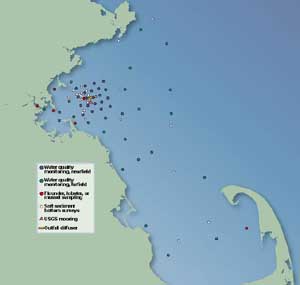|
Boston Harbor
and Massachusetts Bay
After the Outfall: Harbor and Bay Effects BOSTON HARBOR On September 6, 2000 a 9.5-mile outfall began discharging Greater Boston's treated wastewater (effluent) into Massachusetts Bay instead of Boston Harbor. When Deer Island Treatment Plant (DITP) discharges to the harbor ended, dramatic changes occurred near the former harbor outfalls--reductions in bacteria and ammonium concentrations, and improvements in water clarity. Data gathered on the quality of sediments, water, and sea life in Boston Harbor and Massachusetts Bay show that the Massachusetts Bay outfall has been functioning as anticipated–-providing rapid dilution to the effluent–-with no significant adverse impacts. Harbor data show even further improvements as nutrients decrease to levels more typical of a natural estuary. MASSACHUSETTS BAY MWRA's discharge permit for the bay outfall has strict monitoring requirements designed to identify unexpected impacts from operation of the outfall. There is little doubt that the Boston Harbor Project benefits the marine environment and the people of the region, but moving the effluent outfall from the harbor to Massachusetts Bay caused some concern. To address these concerns, MWRA implemented an extensive monitoring program to measure the health of the bay. Monitoring is managed by MWRA staff and carried out by consultant, universities, and government agencies. The bay's water, plankton, sediment, and fish and shellfish are studied to understand how the ecosystem functions, and to measure environmental effects of MWRA pollution abatement projects. To ensure that the bay monitoring is carried out in a scientifically defensible manner, an independent panel of scientists, The Outfall Monitoring Science Advisory Panel (OMSAP), reviews monitoring data and provides advice on scientific issues related to the discharge permit and related monitoring. (Visit OMSAP’s web page). MWRA's goals for Boston Harbor and Massachusetts Bay are based on concerns expressed by the public during the planning of the Boston Harbor Project. These goals include clean beaches, healthy marine resources, seafood safe for eating, and protection of the natural beauty of the harbor and the bay.
|
